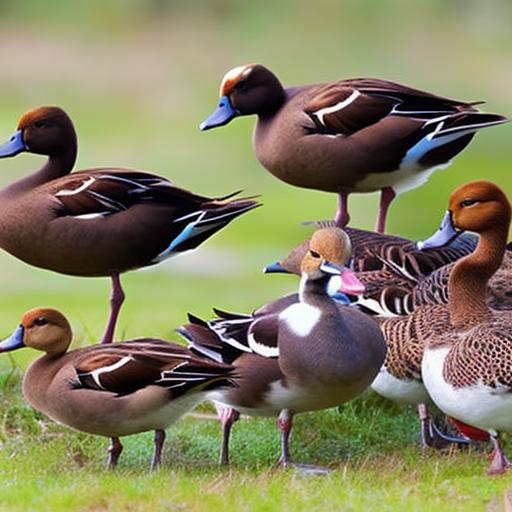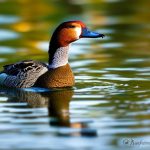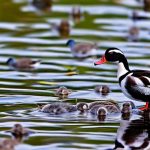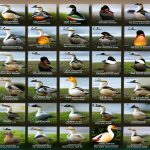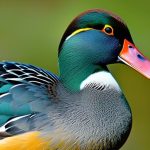Domestic brown ducks are a popular choice among backyard farmers and homesteaders for their versatility and ease of care. These ducks are known for their hardiness, adaptability, and friendly nature, making them a great addition to any small farm or homestead. They are also excellent foragers and can help control pests in the garden or yard.
Key Takeaways
- Domestic brown ducks have been bred for centuries for their meat and eggs.
- The history of domestic brown ducks can be traced back to ancient China and Europe.
- Physical characteristics of domestic brown ducks include a brown plumage, webbed feet, and a broad bill.
- Popular domestic brown duck breeds include the Pekin, Rouen, and Muscovy.
- Male and female domestic brown ducks can be distinguished by their size and plumage.
History of Domestic Brown Duck Breeds
The origins of domestic brown ducks can be traced back to the wild Mallard duck, which is native to North America, Europe, and Asia. Over time, humans began to selectively breed these ducks for specific traits such as size, color, and egg-laying ability. This led to the development of various domestic brown duck breeds that we see today.
Physical Characteristics of Domestic Brown Ducks
Domestic brown ducks come in a variety of sizes and weights, depending on the breed. On average, they range from 4 to 8 pounds in weight. Their feathers can vary in color and pattern, with shades of brown being the most common. Some breeds may have distinct markings or patterns on their feathers.
The bill and leg color of domestic brown ducks can also vary. Most commonly, they have orange or yellow bills and legs. However, some breeds may have darker or lighter colors.
Popular Domestic Brown Duck Breeds
There are several popular domestic brown duck breeds that are commonly found on small farms and homesteads.
Pekin ducks are one of the most popular breeds due to their large size and excellent meat quality. They have white feathers and orange bills and legs.
Rouen ducks are known for their beautiful plumage, which resembles that of wild Mallards. They have a mix of brown, black, and green feathers.
Khaki Campbell ducks are prized for their excellent egg-laying ability. They have khaki-colored feathers and orange bills and legs.
Muscovy ducks are unique in that they are not true ducks but rather a separate species. They have a distinct appearance, with a red face and warty growths on their face and bill.
Differences Between Male and Female Domestic Brown Ducks
Male and female domestic brown ducks can be distinguished by their physical characteristics and behavior.
In terms of physical differences, males are usually larger in size and have more vibrant plumage compared to females. They may also have curled tail feathers or other ornamental features. Females, on the other hand, tend to be smaller and have more subdued plumage.
Behaviorally, males are often more vocal and territorial, especially during the breeding season. They may display aggressive behavior towards other males or even towards humans. Females, on the other hand, are generally more docile and focused on nesting and caring for their young.
Domestic Brown Ducks as Egg Layers
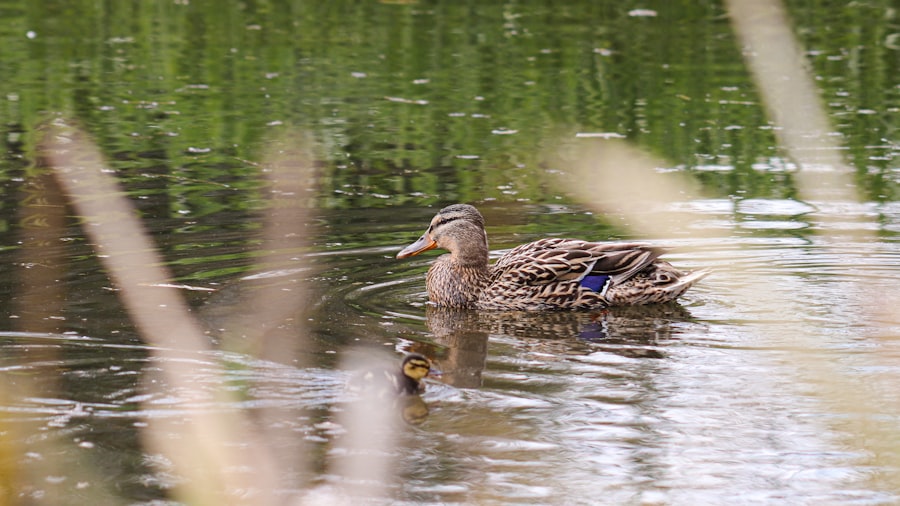
Domestic brown ducks are known for their excellent egg-laying ability. Khaki Campbell ducks, in particular, are renowned for their high egg production rates. On average, a Khaki Campbell duck can lay up to 300 eggs per year.
The size and quality of the eggs produced by domestic brown ducks can vary depending on the breed. Generally, duck eggs are larger than chicken eggs and have a richer flavor. They also have a higher fat content, which makes them ideal for baking.
To ensure optimal egg production, it is important to provide ducks with a balanced diet that includes a good quality poultry feed supplemented with fresh greens and insects. Ducks also require access to clean water for drinking and bathing.
Domestic Brown Ducks as Meat Birds
Domestic brown ducks are also valued for their meat quality and flavor. The Pekin duck breed, in particular, is highly prized for its tender meat and delicious flavor.
Raising ducks for meat is similar to raising chickens or other poultry. Ducks should be provided with a balanced diet that includes a high-quality poultry feed supplemented with fresh greens and insects. They should also have access to clean water for drinking and bathing.
When it comes to processing and cooking duck meat, it is important to properly handle and prepare the meat to ensure food safety. Duck meat can be cooked in a variety of ways, including roasting, grilling, or braising.
Care and Maintenance of Domestic Brown Ducks
Proper care and maintenance are essential for the health and well-being of domestic brown ducks.
Housing requirements for ducks include a secure and predator-proof shelter that provides protection from the elements. Ducks also require access to a clean and spacious outdoor area for foraging and exercise.
Feeding ducks a balanced diet is crucial for their overall health and productivity. A good quality poultry feed should be the main component of their diet, supplemented with fresh greens, vegetables, and insects.
Cleaning and sanitation are important to prevent the spread of diseases. Duck housing should be cleaned regularly, and water sources should be kept clean and free from debris.
Health Issues and Concerns for Domestic Brown Ducks
Like any livestock, domestic brown ducks are susceptible to certain health issues. Common health problems in ducks include respiratory infections, parasites, and nutritional deficiencies.
To prevent illnesses, it is important to provide ducks with a clean and sanitary environment. Regular veterinary care is also essential to monitor their health and address any potential issues.
Conclusion and Future of Domestic Brown Duck Breeds
In conclusion, domestic brown ducks are popular among backyard farmers and homesteaders for their versatility, ease of care, and excellent egg-laying ability. They come in a variety of breeds, each with its own unique characteristics.
Preserving domestic brown duck breeds is important for maintaining genetic diversity and ensuring the future of these valuable birds. As more people become interested in sustainable farming practices, the demand for domestic brown ducks is likely to increase.
In the future, there may be further developments in duck farming and breeding, such as the development of new breeds with specific traits or improved productivity. However, it is important to prioritize the health and well-being of the ducks and to continue to promote responsible and ethical farming practices.
If you’re interested in domestic brown duck breeds, you might also want to check out this informative article on creating the perfect housing for your feathered friends. The article discusses the benefits of using a SnapLock chicken coop, which provides a secure and comfortable environment for your ducks. It also offers creative interior ideas for your chicken coop, ensuring that your ducks have a cozy and functional space to call home. Additionally, the article explores the possibility of turning a shed into a chicken coop, providing step-by-step instructions and helpful tips for repurposing existing structures. To learn more about these innovative housing solutions for domestic brown duck breeds, click here.
FAQs
What are domestic brown duck breeds?
Domestic brown duck breeds are breeds of ducks that have been selectively bred by humans for their meat, eggs, or ornamental purposes. They are typically brown in color and have a variety of physical characteristics.
What are some common domestic brown duck breeds?
Some common domestic brown duck breeds include the Pekin, Rouen, Muscovy, Khaki Campbell, and Indian Runner.
What is the difference between a male and female domestic brown duck?
Male domestic brown ducks, also known as drakes, are typically larger than females and have more colorful plumage. Females, also known as hens, are usually smaller and have less colorful feathers.
What is the lifespan of a domestic brown duck?
The lifespan of a domestic brown duck varies depending on the breed and living conditions, but they typically live between 5-10 years.
What do domestic brown ducks eat?
Domestic brown ducks eat a variety of foods including grains, seeds, insects, and aquatic plants. They also require access to clean water for drinking and bathing.
Can domestic brown ducks fly?
Most domestic brown duck breeds are not strong fliers and can only fly short distances. However, some breeds, such as the Muscovy, are capable of sustained flight.
What are some uses for domestic brown ducks?
Domestic brown ducks are primarily used for their meat and eggs, but they can also be kept as pets or used for ornamental purposes in ponds or gardens.
Meet Walter, the feathered-friend fanatic of Florida! Nestled in the sunshine state, Walter struts through life with his feathered companions, clucking his way to happiness. With a coop that’s fancier than a five-star hotel, he’s the Don Juan of the chicken world. When he’s not teaching his hens to do the cha-cha, you’ll find him in a heated debate with his prized rooster, Sir Clucks-a-Lot. Walter’s poultry passion is no yolk; he’s the sunny-side-up guy you never knew you needed in your flock of friends!

